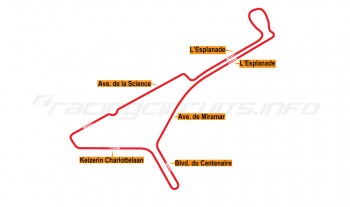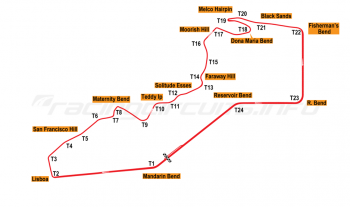Goodwood
Circuit Overview
Goodwood's motor racing circuit is a time capsule, preserved in its 1960s splendour by quirk of history and now revived for racing use once more thanks to its enthusiastic owner, the Duke of Richmond.
It has become home to the Goodwood Revival meeting each year since 1998, building on the success of the nearby Goodwood Festival for classic and historic cars at the hillclimb course laid out at the Earl of March's home. A second event, the Members Meeting, made its debut in 2014 and is only open to Goodwood Road and Racing Club members, so has a more exclusive feel.
Outside of these events, the circuit remains abuzz with activity for most of the year, including track days, manufacturer promotional days and general testing.
Circuit History
The Goodwood Estate had a brief association with speed events, pre-dating the circuit. In 1936, the 9th Duke of Richmond – a keen motoring enthusiast and amateur racer (he won the 1930 Brooklands 500 in an Austin Seven) – organised a hillclimb on the roads around the estate for a small group of pre-war Lancia enthusiasts. World events would limit any further runnings but would also provide the opportunity that would eventually lead to the creation of the circuit.
As tensions with Germany began to escalate in 1938, the Duke was summoned to the Air Ministry and appraised of the need for more military airfields. He agreed that farming land, south of the famous horse racing track and the house itself, would be given over to the construction of a satellite airfield to nearby RAF Tangmere. Built as an emergency landing airfield for fighter aircraft, it consisted of three grass runways encircled by a 2.4 mile perimeter road. Made operational as RAF Westhampnett during the Battle Of Britain, it was home to Spitfire Squadrons and also Hurricanes. The USAF moved in after the RAF dispersed their squadrons to other airfields and largely flew Spitfires and Typhoons. It ended its operational life in 1946, after which it passed back to the Duke's control.
In the immediate post-war era, Britain's motor racing infrastructure was in a poor state. Brooklands has been given over to aircraft production; Crystal Palace was in a state of disrepair and Donington Park remained in military hands, being used as a vehicle storage facility. While still serving with the RAF, the Duke of Richmond was approached by fellow enthusiast Tony Gaze (then a Squadron Leader in the RAF) who suggested Westhampnett would make a good circuit. His interest piqued, the Duke set out in his Lancia Aprilia to tour the perimeter road. Despite its poor condition, he could see the potential and invited motor racing journalist and driver Tommy Wisdom to tour the facility. Together, the pair began planning the circuit's creation.
The Duke was president of the Brooklands Automobile Racing Club (soon to be renamed the British Automobile Racing Club) and so he naturally turned to them to assist. Three miles of fencing had be erected and repairs made to the track surface, but in 1948 the new Goodwood Circuit was ready for racing. The first race was held on on 18 September 1948, Paul de Ferranti C. Pycroft taking victory in his 2,664 c.c. Pycroft-Jaguar, at 66.42 mph. The main race, the Goodwood Trophy, fell to Reg Parnell's Maserati 4CLT/48, with a lap record of 88.56 mph. Stirling Moss won the accompanying 500cc race in a Cooper, his first major victory. The event proved a huge success – it was televised live on the BBC and also attracted 15,000 spectators.
Increasing lap speeds over the next two years gave rise to safety concerns and in 1952 the Duke insisted something should be done to slow the circuit. The solution was the now famous chicane, inserted just before the pits. It was a substantial structure with brick walls at the apexes, owing perhaps more in design to the world of horse racing than motor racing. It soon became one of the most photographed areas of the track. At the same time, the entire circuit was resurfaced.
The 1952 season also saw the debut of one of Goodwood's signature events, the Nine Hours. This was the longest race in England at the time and the first to feature night racing, running from 3pm to midnight. It would attract some of the biggest teams in sportscar racing, though was only repeated twice more in 1954 and '55. The other famous race was the Glover Trophy, a non-championship affair for Formula One machinery, which ran from 1949 to '65. This race was probably most notable for seeing the crash in 1962 at St Mary's Corner which effectively ended the career of Stirling Moss.
Over its original operating years Goodwood saw some some of the most significant names in motor racing featuring on the competition bill; Moss was a multiple winner, as were Mike Hawthorn, John Surtees, Jim Clark and Jack Sears. The circuit also saw a demonstrations of Donald Campbell's Bluebird CN7 Land Speed Record car in 1960 and 1962. With only four degrees of steering lock, the car was effectively run at tickover speed, though still achieved 100mph on one of the straights.
In 1965, in response to rising lap times, events were restricted to cars under 3 litres, but the speeds continued to be a concern. In August 1966, the Duke – concerned by general safety in motorsport – ordered the gates be closed for racing for the final time. The last race was won by Christopher Metcalfe in a club meeting organised by the British Automobile Racing Club on 2 July 1966.
Closure to racing is not the end of the story
Perhaps unusually, the circuit roads and pit facilities remained well-tended and Goodwood remained available for sprint meetings and general testing. It was during a test in 1970 that Bruce McLaren lost his life when a rear bodywork failure on McLaren's M8D Can-Am car caused it to spin and leave the track on the Lavant Straight. The car hit a bunker used as a flag station and McLaren was thrown from the wreckage, killed in an instant. It was one of Goodwood's blackest days.
The circuit continued in its semi-dormant state for the next 30 years until it began its revival under the Earl of March (now the Duke of Richmond). In the early 1990s, after assuming responsibility for the running of his father's estate, Lord March sought to return motor racing to Goodwood, but struggled to get the relevant permits. Instead, he turned his attention to the hillclimb course and from 1993 has hosted the annual Goodwood Festival of Speed, which has quickly become one of the premier historic motor racing showcases.
Off the back of this success, in September 1996 Lord March was successful in his bid to return racing to the circuit. Racing would be permitted for up to five days a year after protesters were overruled. Much work was needed to bring spectator facilities up to modern standards, though the restoration would be sympathetic to its period history. 270,000 tonnes of earth were brought onto the site to create the required acoustic banking, while a new safety barrier around the track's perimeter was created from some 20,000 lorry tyres and a further 7,000 car tyres. Ivy plants were used to disguise the new barriers. The circuit required a special homologation and is the only one in the world to have the FIA Grade 4 Historic designation.
After more than a year of preparation, the first Goodwood Revival meeting took place on 18-20 September 1998, the first day being the 50th anniversary of the circuit's original opening. Lord March toured the track in a Bristol 400, much as his grandfather had done in 1948, before racing commenced in earnest. The Revival sees historic cars from the period of the original circuit compete in closely-fought competition, with the majority of the crowd getting into the spirit by attending in period costume. No modern vehicles (save for emergency services) are permitted within the circuit confines during the event, helping to preserve the time-capsule feel.
The honour of winning Goodwood's first race in 32 years fell to Ludovic Lindsay at the wheel of the famous ex-Prince Bira ERA 'Remus'. The Revival event has become as big a success as the Festival of Speed and is keenly anticipated each year. Famous names who took part in the circuit's heyday have also competed in the revival, including Sir Stirling Moss, John Surtees, Sir Jack Brabham and Phil Hill, while the likes of Derek Bell, David Coulthard, Damon Hill, Martin Brundle, Peter Brock and motor cycle legends Wayne Gardner and Giacomo Agostini have also taken part. The late Barry Sheene took part in his final race on UK shores in 2008 at Goodwood, shortly before his death from cancer.
In 2014, the circuit launched a second event (using the remainder of its permitted racing days), aimed at members of the Goodwood Road Racing Club. It aims to recreate the atmosphere and camaraderie of the original BARC Members' Meetings held 'in period' at Goodwood through the 1950s and 1960s. The invitation-only event gives visitors the chance to see demonstrations of racing cars never seen at Goodwood in period, from F1 cars from the 1970s, to the biggest collection of McLaren F1 GTRs ever assembled and Group C Le Mans cars all taking to the track. With access-all areas, there is a unique chance to mingle with the stars and their cars.
As well as motorsport, Goodwood has also seen other sporting activity. In 1982, the UCI held the Cycle Road Racing World Championships at the circuit. In the men's professional race, a late breakaway by the American rider Jacques Boyer was closed down by a pack led by Boyer's team-mate (and future triple Tour de France winner and double Road World Champion) Greg LeMond, who was in turn pipped in the final sprint by Giuseppe Saronni, earning the Italian the nickname of the 'Goodwood Rifle Shot'.
The circuit is also host each year to the National Finals of the Greenpower schools electric car racing challenge, while in 2014, motorcycle racer and daredevil Guy Martin teamed with mountain biker Jason Miles to set a new distance record of 316.79 miles for tandem bicycle riding in a 24-hour period.
Jump onboard
Circuit info
- Goodwood Motor Circuit, Chichester, West Sussex, PO18 0PH, United Kingdom
- +44 1243 755060
- Email the circuit
- Official website
Rate This Circuit
Votes: 4976
Plan a visit
Get your race tickets!
Brought to you with: 
We've teamed up with Motorsports Tickets to bring you the best deals for Formula One, MotoGP, Le Mans and more.











